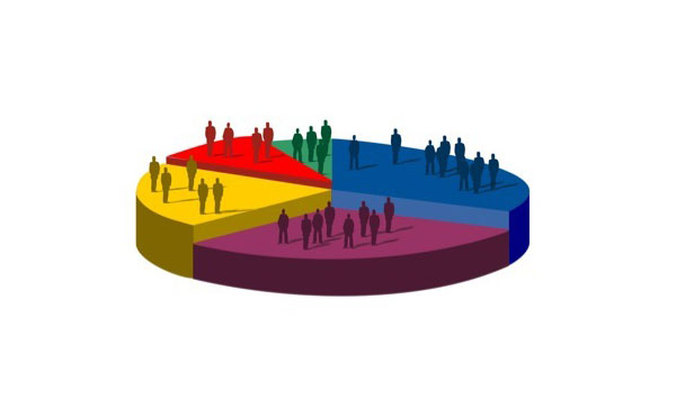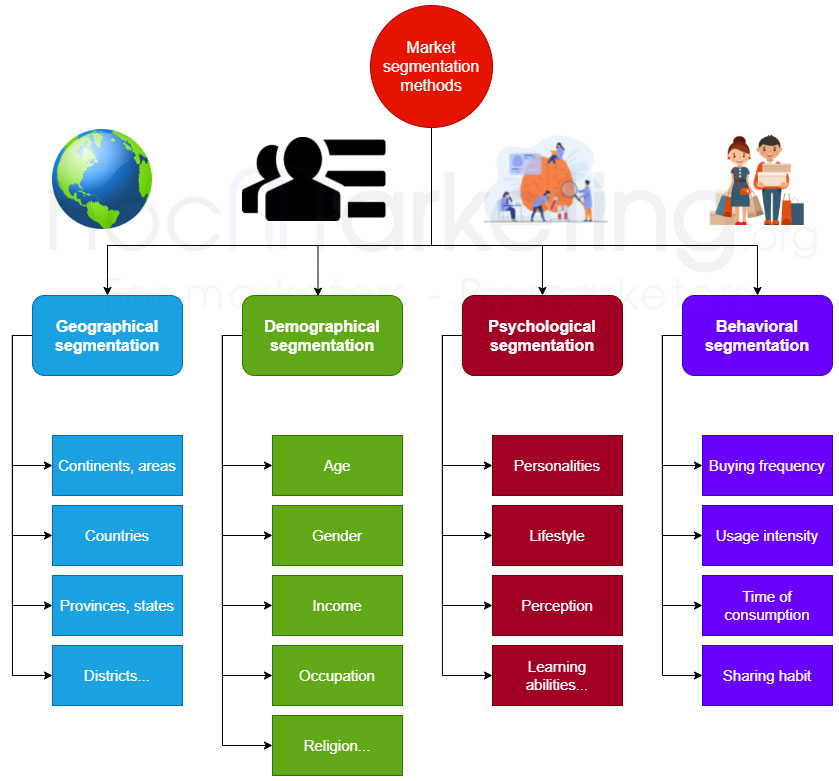
What is market segmentation? How to segment a market?

When the market economy is the common standard model of the world, most of the competition between enterprises in the fields of production and business will increase, as more and more businesses set foot in the market. In this article, we are going to find out what is market segmentation and common methods to segment a market.
When the market economy is the common standard model of the world, most of the competition between enterprises in the fields of production and business will increase, as more and more businesses set foot in the market. In this article, we are going to find out what is market segmentation and common methods to segment a market.
What is market segmentation?
Market segmentation is the act of dividing a market into smaller distinctive groups (segments) of customers. Customers in a segment share similar or the same characteristics, such as geographical, demographic, psychographic... characteristics.
For example: Smartphone manufacturers usually devide their market in to segments based on their customers's income:
- Affordable segment: Target customers who have low income and look for smartphones with basic functions, features at an affordable price.
- Advanced segment: Target customers who have fair income. In addition to basic functions and features of smartphones such as calling, messeging, photo taking, video recording... they also look for smartphones which can bring better experience in using (high-definition screen, fast and stable processing, good-looking design...)
- Prestige segment: Target customers who have high income and are always ready to spend on latest realeased "flagships". Phones for a prestige segments usually possess latest technologies, a luxurious design, fastest performance...
Roles of market segmentation in Marketing
Why does a firm need to segment a market?
When the market economy is the common standard model of the world, most of the competition between enterprises in the fields of production and business will increase, as more and more businesses set foot in the market. Therefore, businesses cannot apply the same marketing strategy as before when they pool all customers in the market to serve with the same product/service, because this reduces their competitiveness. business compared to other competitors.
By dividing the market into smaller markets to serve, market segmentation helps businesses save resources, as well as operate more efficiently when products and services can meet the needs of customers. meet the needs of target customers in a better way.
Market segmentation is the first step for businesses to build distinctive values for their products/services, thereby creating a brand with their own characteristics, helping customers not to be confused with the products/services of other competitors.
Market Segmentation Methods
According to the results of the researches, there are a total of 4 market segmentation methods that are commonly applied in enterprises, including: Geographical segmentation, demographical segmentation, psychosocial segmentation, consumer-behavioral segmentation.
1. Geographical segmentation
Businesses using geographic segmentation can segment the market into small subdivisions based on geographical factors such as continents, countries, regions, states and states, provinces, and districts...
For examples:
- CocaCola segmented the market by country (USA, China, Japan, Korea...). Coca-Cola products in each country may differ in taste, design, brand. Coca-Cola's advertising programs and campaigns also vary from country to country.
- Dart and True Temper are firms providing snow shovels in countries with cold temperatures and where snowfall is a normal occurrence. There is no point in marketing snow shovel in areas that are either warm or mildly cold areas with no snowfall.
2. Demographical segmentation
Businesses segment the market based on demographic characteristics such as age, gender, occupation, income, religion, generation...
Examples:
- Fashion shops will often segment the market by gender (Fashion for Men, Fashion for Women) or by age (Fashion for children, youth, the elderly).
- Smartphone manufacturers segment the market by income level: Budget (for low-income people), universal (for middle-income people) & high-end (for people with low incomes) high entry).
3. Psychological segmentation
Businesses can segment the market based on psychosocial characteristics such as individual personality, perception, lifestyle, learning ability, opinion, style, preferences...
Examples:
- Royal Dutch Gazelle, a famous bicycle manufacturer based in the Netherlands, manufactures a wide range of bicycles to satisfy a wide range of customers. The City Bikes line mainly serves customers who like to go to work by bicycle in the inner city. The Robust Classic series is aimed at customers who are families with a royal lifestyle. Trekking bikes are for customers who like sports activities.
4. Consumer-behavioral segmentation
Enterprises can subdivide the market according to the behavior and consumption habits of customers, typically the time of purchase (events, holidays, etc.), intensity of use, purpose of use...
Examples:
- Fitbit, a well-known manufacturer of gym equipment based in California, USA, manufactures different devices based on segments including customers with daily exercise needs, customers with daily exercise needs high intensity training.
- Supermarkets and convenience stores can segment the market by buying habits (customers buy few products/time but buy many times/month, customers buy many products/time but buy few times/month).
Can you combine different segmentation methods?
Sure, you can combine 2 or more different segmentation methods to get your own segments tailored to the strategic characteristics of each business, as long as the criteria listed below are met. .
Requirments for each market segment
Any market segment needs to meet the following criteria:
- Ability to distinguish: The distinguishing characteristics between segments must be clear, especially when businesses apply the same Marketing program (For example, the same new iPhone model but how to react of the market segment in Western countries will be with those in the Chinese market segment)
- Match the resources of the business: The resources of the business must ensure to satisfy the needs of customers in the segment.
- Feasibility for surveys and measurements: Through conducting surveys and research, businesses can measure factors such as segment size, purchasing power, profitability...
- Within the reach and reach of the business: Businesses can reach customers in the segment easily.
- Profitable: When separating the segment, the business must be able to profit from the needs and characteristics of the customers in that segment.



















